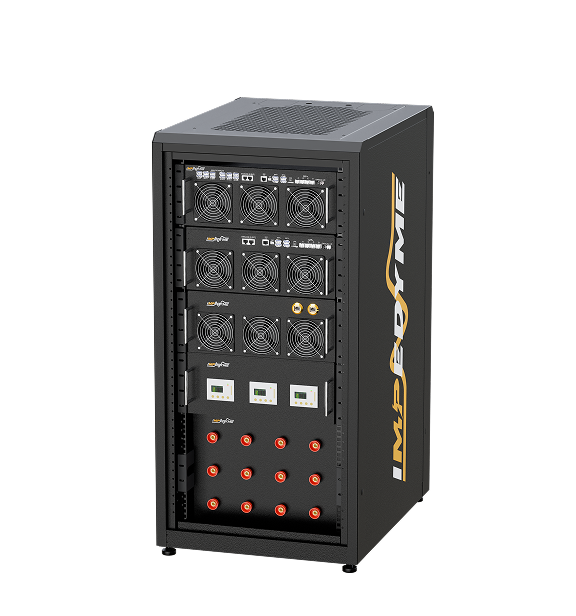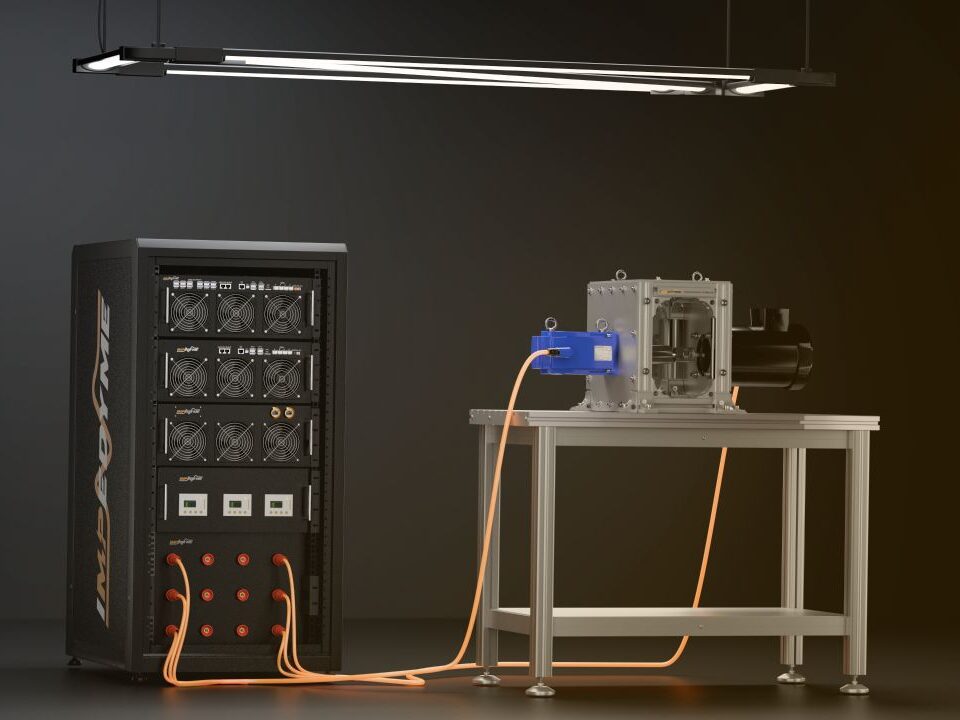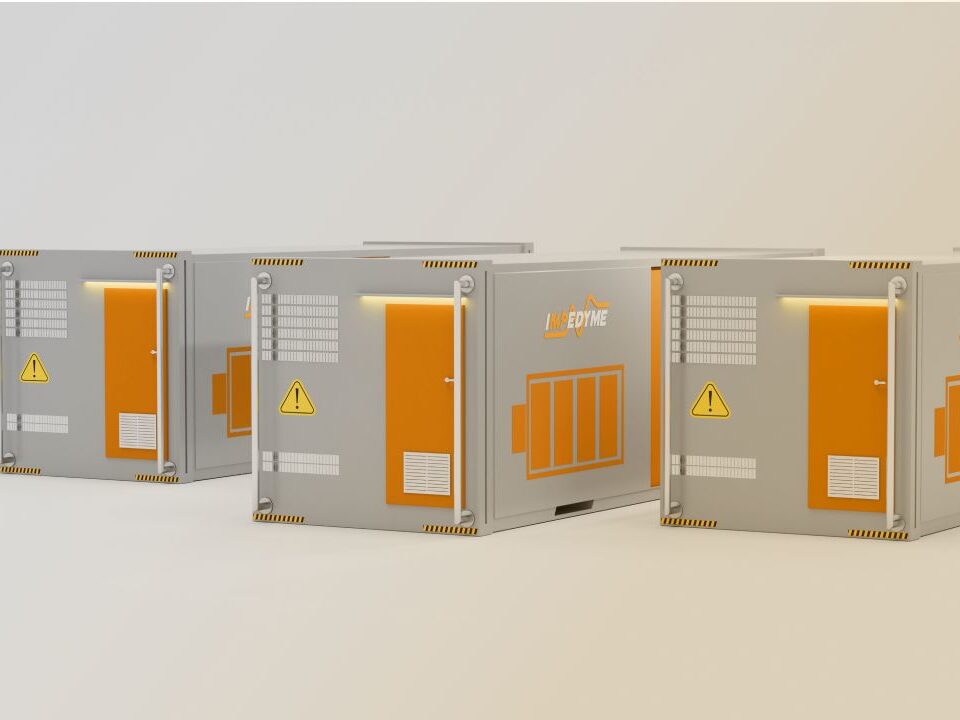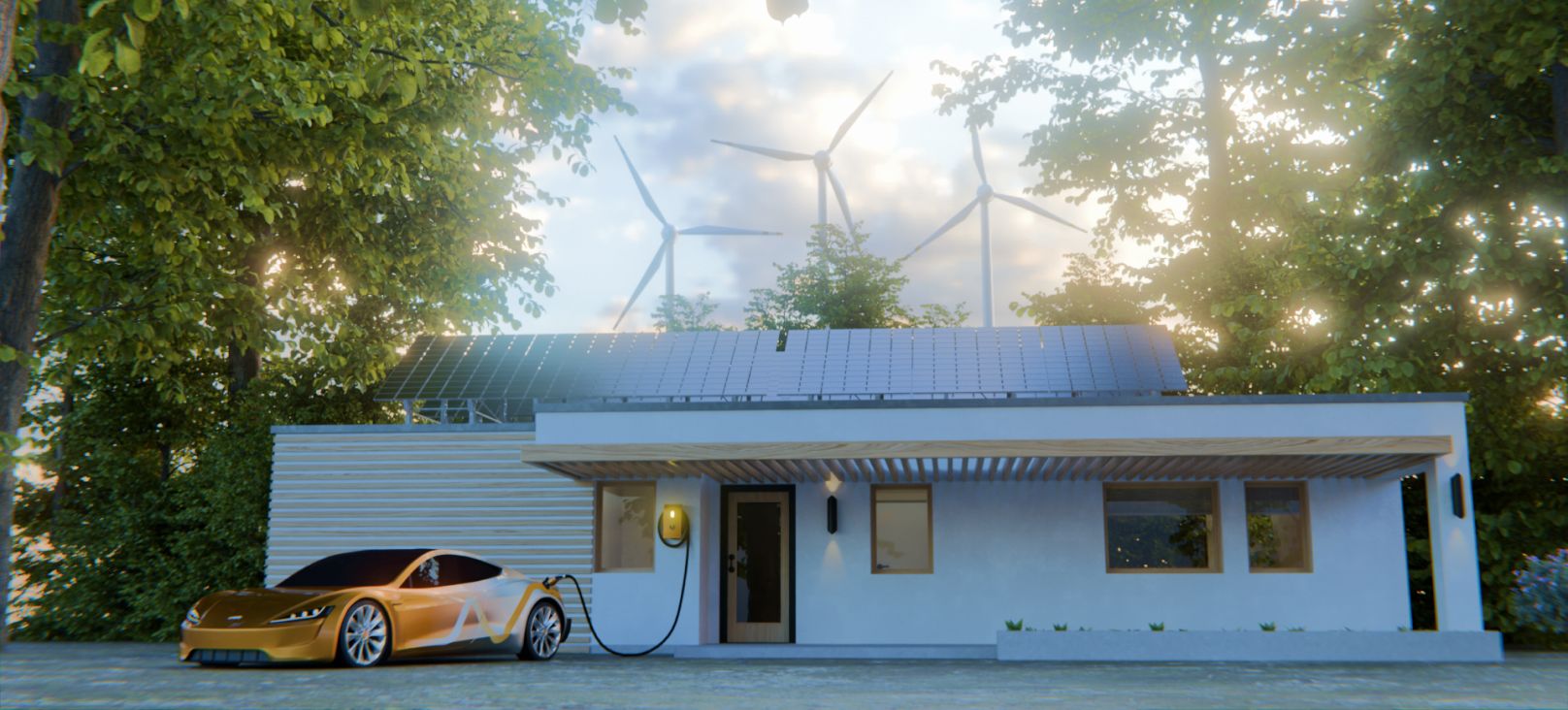
-
 Induction Motor
Induction Motor
-
 Automotive Electrical System Simulation
Automotive Electrical System Simulation
-
 DC/DC Bidirectional Converter
DC/DC Bidirectional Converter
-
 PWM Control for Brushless DC
PWM Control for Brushless DC
-
 BLDC Motor Control and Drive Simulation
BLDC Motor Control and Drive Simulation
-
 Electric Vehicle Fast Charger Simulation
Electric Vehicle Fast Charger Simulation
-
 DFIG Wind Turbine Simulation
DFIG Wind Turbine Simulation
-
 Dual Active Bridge
Dual Active Bridge
-
 EV Dynamometer Test Environment Simulation
EV Dynamometer Test Environment Simulation
-
 Electric Vehicle Simulation
Electric Vehicle Simulation
-
 Three-Phase Grid-Connected Inverter Using Direct-Q…
Three-Phase Grid-Connected Inverter Using Direct-Q…
-
 Three-Phase Grid-Connected Solar Photovoltaic
Three-Phase Grid-Connected Solar Photovoltaic
-
 Grid-Connected Rectifier
Grid-Connected Rectifier
-
 Grid-Tied Inverter System
Grid-Tied Inverter System
-
 Torque Control in a Hybrid Excitation Synchronous …
Torque Control in a Hybrid Excitation Synchronous …
-
 Wye-Delta Starting Circuit
Wye-Delta Starting Circuit
-
 IPMSM-Based Axle-Drive
IPMSM-Based Axle-Drive
-
 Simplified Parallel Hybrid Electric Vehicle
Simplified Parallel Hybrid Electric Vehicle
-
 Simplified Series Hybrid Electric Vehicle
Simplified Series Hybrid Electric Vehicle
-
 Series-Parallel Hybrid Electric Vehicle
Series-Parallel Hybrid Electric Vehicle
-
 Three-Phase Matrix Converter Simulation
Three-Phase Matrix Converter Simulation
-
 Venturini Modulation for Three-Phase Matrix Conver…
Venturini Modulation for Three-Phase Matrix Conver…
-
 Microgrid Frequency Regulation Using Vehicle-to-Gr…
Microgrid Frequency Regulation Using Vehicle-to-Gr…
-
 Three-Phase Modular Multilevel Converter
Three-Phase Modular Multilevel Converter
-
 Field-Oriented Control
Field-Oriented Control
-
 Interior Permanent Magnet Synchronous Generator
Interior Permanent Magnet Synchronous Generator
-
 Permanent Magnet Synchronous Machine
Permanent Magnet Synchronous Machine
-
 PMSM Rotor Angular Velocity
PMSM Rotor Angular Velocity
-
 PMSM-Based Electrical Traction Drive
PMSM-Based Electrical Traction Drive
-
 Maximum Power Point Tracking
Maximum Power Point Tracking
-
 Six-Phase Permanent Magnet Synchronous Machine
Six-Phase Permanent Magnet Synchronous Machine
-
 Synchronous Machine-Based Electrical Drive Simulat…
Synchronous Machine-Based Electrical Drive Simulat…
-
 Single-Stage Solar Inverter
Single-Stage Solar Inverter
-
 Three-Phase Cycloconverter Simulation
Three-Phase Cycloconverter Simulation
-
 Totem-Pole PFC Simulation
Totem-Pole PFC Simulation
-
 Twelve-Pulse Thyristor Rectifier
Twelve-Pulse Thyristor Rectifier
-
 Two-Wheeler On-Board Charger
Two-Wheeler On-Board Charger
-
 Vienna Rectifier Simulation
Vienna Rectifier Simulation
-
 High-Voltage Direct Current
High-Voltage Direct Current
-
 Wireless Power Transfer
Wireless Power Transfer

Comprehensive Documentation for Three-Phase Grid-Connected Solar Photovoltaic (PV) System Simulation
Table of Contents
- 1 Comprehensive Documentation for Three-Phase Grid-Connected Solar Photovoltaic (PV) System Simulation
- 1.1 Introduction
- 1.2 System Overview
- 1.2.1 What is a Grid-Connected PV System?
- 1.2.2 Purpose of the Simulation
- 1.3 Key Features
- 1.3.1 Maximum Power Point Tracking (MPPT)
- 1.3.2 DC-DC Converter for Voltage Regulation
- 1.3.3 Three-Phase Grid-Connected Inverter
- 1.3.4 Phase-Locked Loop (PLL) for Grid Synchronization
- 1.3.5 Efficient Power Generation
- 1.3.6 Grid Stability
- 1.3.7 Cost Savings
- 1.3.8 Compliance with Standards
- 1.4 Simulation Objectives
- 1.5 Technical Description
- 1.5.1 System Configuration
- 1.5.2 Control Methodology
- 1.6 Advantages of Grid-Connected PV Systems
- 1.7 Applications
- 1.7.1 Utility-Scale Solar Power Plants
- 1.7.2 Commercial and Industrial Solar Installations
- 1.7.3 Microgrids and Distributed Generation
- 1.7.4 Energy Storage Integration
- 1.7.5 Electric Vehicle (EV) Charging Infrastructure
- 1.7.6 Agricultural Applications
- 1.7.7 Water Pumping and Desalination
- 1.8 Simulation Benefits
- 1.9 Summary
- 1.10 Future Enhancements
- 1.10.1 Induction Motor
- 1.10.2 Automotive Electrical System Simulation
- 1.10.3 DC/DC Bidirectional Converter
- 1.10.4 PWM Control for Brushless DC
Introduction
Grid-connected solar photovoltaic (PV) systems play a critical role in renewable energy integration by efficiently injecting solar power into the electrical grid. This model simulates a three-phase grid-connected PV system with maximum power point tracking (MPPT) and different inverter options to achieve stable operation and optimal power transfer. The simulation provides insights into PV energy conversion, grid synchronization, and power quality improvements.
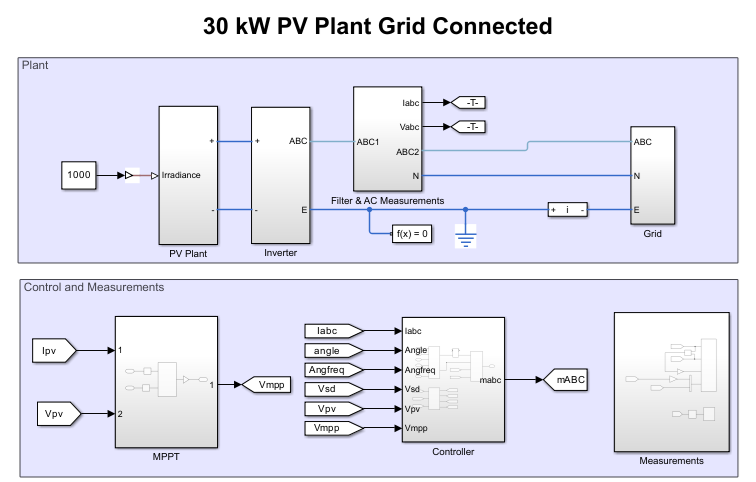
System Overview
What is a Grid-Connected PV System?
A grid-connected PV system consists of solar panels, a DC-DC converter (with MPPT), and a three-phase inverter that synchronizes with the grid. It allows for efficient solar energy harvesting and stable power injection into the utility grid.
Purpose of the Simulation
The simulation aims to:
- Analyze the energy conversion efficiency of PV panels.
- Evaluate MPPT techniques for optimal power extraction.
- Validate inverter control strategies for stable grid integration.
Key Features
Maximum Power Point Tracking (MPPT)
The system implements MPPT algorithms (e.g., Perturb and Observe, Incremental Conductance) to maximize power extraction from solar panels.
➡️ HIL/PHIL Benefit: Enables real-time MPPT evaluation under dynamic solar conditions.
DC-DC Converter for Voltage Regulation
A boost converter regulates the PV array voltage and ensures stable DC-link voltage for the inverter.
➡️ HIL/PHIL Benefit: Allows hardware testing of converter control algorithms.
Three-Phase Grid-Connected Inverter
An IGBT-based three-phase inverter converts DC power into AC and ensures synchronization with the grid.
➡️ HIL/PHIL Benefit: Validates grid-tied inverter performance under real-world conditions.
Phase-Locked Loop (PLL) for Grid Synchronization
The PLL ensures phase and frequency synchronization between the inverter and the grid.
➡️ HIL/PHIL Benefit: Enables robust testing of grid synchronization techniques.
Efficient Power Generation
Simulations optimize the design and operation of solar PV systems, maximizing energy output and efficiency.
Grid Stability
Simulations ensure stable integration of solar power into the grid, improving voltage regulation and frequency stability.
Cost Savings
By identifying potential issues early in the design phase, simulations reduce the cost of prototyping and testing.
Compliance with Standards
Simulations ensure that solar PV systems meet industry standards and regulations for safety and performance.
Simulation Objectives
This simulation helps evaluate:
- PV energy conversion efficiency under varying solar irradiance.
- MPPT algorithm effectiveness for real-time power tracking.
- Grid-tied inverter performance for stable operation.
➡️ HIL/PHIL Benefit: Ensures real-time control validation before deployment.
Technical Description
System Configuration
- Input: Solar PV array with variable irradiance conditions.
- Output: Three-phase AC power injected into the grid.
- Power Stage: DC-DC boost converter + Three-phase inverter.
Control Methodology
- MPPT Algorithms: Perturb & Observe (P&O), Incremental Conductance (IncCond).
- DC-DC Converter Control: Voltage and current regulation.
- Grid Inverter Control: DQ-based active and reactive power control.
➡️ HIL/PHIL Benefit: Provides real-time validation of different control strategies.
Advantages of Grid-Connected PV Systems
- Efficient Solar Energy Utilization: Extracts maximum power under changing conditions.
- Stable Grid Synchronization: Ensures reliable and safe power injection.
- Improved Power Quality: Reduces harmonics and enhances voltage stability.
➡️ HIL/PHIL Benefit: Allows pre-deployment testing for grid compliance.
Applications
Utility-Scale Solar Power Plants
Power Generation Optimization: Simulations are used to optimize the design and operation of large-scale solar farms, maximizing energy output and efficiency.
Grid Integration: Simulations ensure stable integration of solar power into the grid, analyzing voltage regulation, frequency stability, and power quality.
Fault Analysis: Simulations study the behavior of solar PV systems under grid faults, ensuring reliable operation and compliance with grid codes.
Commercial and Industrial Solar Installations
Rooftop Solar Systems: Simulations are used to design and optimize rooftop solar installations for commercial and industrial buildings, ensuring efficient energy generation and grid compatibility.
Energy Cost Reduction: Simulations help businesses analyze the economic benefits of solar PV systems, reducing energy costs and improving sustainability.
Load Matching: Simulations optimize the alignment of solar power generation with on-site energy consumption, reducing reliance on grid power.
Microgrids and Distributed Generation
Islanded Microgrids: Simulations are used to design solar PV systems for islanded microgrids, ensuring reliable power supply in remote areas.
Grid-Connected Microgrids: Simulations optimize the integration of solar PV systems into grid-connected microgrids, enabling seamless transition between grid-connected and islanded modes.
Hybrid Energy Systems: Simulations help design hybrid systems combining solar PV with other energy sources (e.g., wind, batteries) for stable and efficient power generation.
Energy Storage Integration
Battery Energy Storage Systems (BESS): Simulations are used to integrate solar PV systems with battery storage, optimizing energy management and grid stability.
Peak Shaving: Simulations analyze the use of solar PV and storage to reduce peak demand charges, improving economic efficiency.
Grid Services: Simulations validate the ability of solar PV systems with storage to provide grid services like frequency regulation and voltage support.
Electric Vehicle (EV) Charging Infrastructure
Solar-Powered Charging Stations: Simulations are used to design solar PV systems for EV charging stations, ensuring efficient power generation and grid compatibility.
Bidirectional Charging (V2G): Simulations analyze the integration of solar PV systems with V2G technology, enabling EVs to feed power back into the grid.
Agricultural Applications
Solar-Powered Irrigation: Simulations are used to design solar PV systems for agricultural irrigation, providing a sustainable and cost-effective energy solution.
Rural Electrification: Simulations help design solar PV systems for rural electrification, improving access to electricity in remote areas.
Water Pumping and Desalination
Solar-Powered Water Pumping: Simulations are used to design solar PV systems for water pumping in agricultural, industrial, and municipal applications.
Desalination Plants: Simulations optimize the integration of solar PV systems with desalination plants, supporting water supply in arid regions.
➡️ HIL/PHIL Benefit: Enables real-time testing under diverse grid conditions.
Simulation Benefits
With this simulation, users can:
- Analyze PV system performance and efficiency.
- Test and optimize MPPT and inverter control algorithms.
- Evaluate grid integration challenges and power quality issues.
➡️ HIL/PHIL Benefit: Facilitates seamless transition from simulation to real-world deployment.
Summary
The Three-Phase Grid-Connected PV System Simulation provides a detailed framework for studying solar power integration with grid-connected inverters. Impedyme’s HIL and PHIL solutions enhance the development process:
| Development Stage | Impedyme’s Contribution |
|---|---|
| PV System Modeling | HIL for real-time solar energy simulation |
| MPPT Algorithm Testing | HIL validation under dynamic irradiance |
| Grid Synchronization | PHIL-based real grid interaction |
| Power Quality Assessment | THD analysis with real-time inverter control |
Future Enhancements
- Integration of AI-based MPPT for faster response times.
- Development of advanced fault detection and grid-support functionalities.
- Simulation of next-generation PV inverters with wide-bandgap devices (SiC/GaN).
The Three-Phase Grid-Connected PV System Simulation provides a comprehensive testing environment for optimizing PV energy conversion and grid integration. With Impedyme’s HIL/PHIL solutions, engineers can enhance efficiency, stability, and power quality, ensuring seamless renewable energy deployment into the electrical grid.
